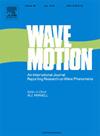Knopoff 等人对时间和空间 Q 之间关系的测试。
IF 2.1
3区 物理与天体物理
Q2 ACOUSTICS
引用次数: 0
摘要
品质因数是衰减介质中波模式每周期能量损失的无量纲测量值。精确测量在各个领域都很重要,从检测部分融化区的地震学研究,到研究岩石特性(如孔隙度、流体特性、饱和度和渗透性)的储层地球物理学。在地震学中,正常(驻波)模式和传播波测量的质量因子不同,实验室中基于共振棒和超声波脉冲的等效实验的质量因子也不同。这些测量结果分别产生了时间品质因数和空间品质因数。六十年前,Knopoff 等人提出了这两种不同品质因数与相应衰减系数之间的关系。转换系数基本上是相位速度和群速度的比值,而衰减系数则是群速度。我们使用开尔文-伏依格特流变学和恒定 Q 模型对这些关系进行了检验,这些关系在低损耗固体和体波中都是成立的,它们提供了这些关系中涉及的时间和空间品质因数和速度的明确表达式。所提出的理论为基于任意应力应变关系完整描述时空品质因数和速度散布提供了基础。本文章由计算机程序翻译,如有差异,请以英文原文为准。
Test of the relation between temporal and spatial Q by Knopoff et al.
The quality factor is a dimensionless measure of the energy loss per cycle of wave modes in an attenuation medium. Accurate measurement is important in various fields, from seismological studies to detect zones of partial melting to the geophysics of reservoirs to study rock properties such as porosity, fluid properties and saturation and permeability. In seismology, the quality factors measured for normal (standing) modes and propagating waves differ, as well those of equivalent experiments based on resonant rods and ultrasonic pulses performed in the laboratory. These measurements result in temporal and spatial quality factors respectively. A relationship between these two different quality factors and between the corresponding attenuation factors was proposed by Knopoff et al. sixty years ago. The conversion factor is basically the ratio between the phase velocity and the group velocity, while for the attenuation factor is the group velocity. We test these relations, which hold for low-loss solids, for body waves, using a Kelvin–Voigt rheology and a constant model, which provide explicit expressions of the temporal and spatial quality factors and velocities involved in these relations. The proposed theory provides the basis for a complete characterization of temporal and spatial quality factors and velocity dispersion based on arbitrary stress–strain relationships.
求助全文
通过发布文献求助,成功后即可免费获取论文全文。
去求助
来源期刊

Wave Motion
物理-力学
CiteScore
4.10
自引率
8.30%
发文量
118
审稿时长
3 months
期刊介绍:
Wave Motion is devoted to the cross fertilization of ideas, and to stimulating interaction between workers in various research areas in which wave propagation phenomena play a dominant role. The description and analysis of wave propagation phenomena provides a unifying thread connecting diverse areas of engineering and the physical sciences such as acoustics, optics, geophysics, seismology, electromagnetic theory, solid and fluid mechanics.
The journal publishes papers on analytical, numerical and experimental methods. Papers that address fundamentally new topics in wave phenomena or develop wave propagation methods for solving direct and inverse problems are of interest to the journal.
 求助内容:
求助内容: 应助结果提醒方式:
应助结果提醒方式:


